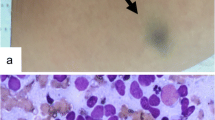Abstract
Background
Age at diagnosis is an important risk factor in neuroblastoma (NB) with worse prognosis in children older than 18 months. A more indolent course with long-term relapses and fatal outcome has been described in small series of adolescents. Our objective was to describe biological factors that contribute to this particular behaviour and could be helpful in their treatment.
Procedure
NB cases older than 10 years of age at diagnosis registered in the files of the Neuroblastoma Group of SEOP from 1992 to 2007 were included. Disease extension was classified according to the International Neuroblastoma Staging System (INSS). Tumour samples were studied according to the International Neuroblastoma Pathology Classification (INPC). Biological studies included MNA, 1p, 11q and 17q status and ploidy.
Results
Twenty-two patients, from 10.1 to 24.6 years old, were included. Advanced stages predominated. 14/17 patients presented unfavourable histology. None had NMA or 1p del. However, 11q del was found in 8/13 cases and 17q gain in 7/11. Overall survival (OS) and event-free survival (EFS) for the entire series at 5 years were 0.45 and 0.32, respectively. Moreover, 5-year OS and EFS for stage 4 patients were 0.33 and 0.15.
Conclusions
NB in adolescents is a special subgroup characterised by high-risk prognostic features which differ from those seen in younger patients, especially in relation to genetic abnormalities. The outcome in stage 4 was worse than in younger metastatic children, outlining the need for new therapeutic approaches in this subgroup of patients. The exact cut-off to separate older patients has not yet been established and will probably be based on biology.
Similar content being viewed by others
References
Brodeur GM, Maris JM (2002) Neuroblastoma. In: Pizzo PA, Poplack DG (eds) Principles and practice of paediatric oncology, 4th edn. JB Lippincott, Philadelphia, pp 895–938
Castel V, Canete A (2005) Tumores de la cresta neural. In: Madero L, Munoz A (eds) Hematologia y Oncologia Pediatrica, 2nd edn. Ergon, Madrid, pp 571–586
London WB, Castleberry RP, Matthay KK et al (2005) Evidence for an age cut-off greater than 365 days for neuroblastoma risk group stratification in the Children’s Oncology Group. J Clin Oncol 23:6459–6465
Blatt J, Gula MJ, Orlando SJ et al (1995) Indolent course of advanced neuroblastoma in children older than 6 years at diagnosis. Cancer 76:890–894
Franks LM, Bollen A, Seeger RC et al (1997) Neuroblastoma in adults and adolescents: an indolent course with poor survival. Cancer 79:2028–2035
Kushner BH, Kramer K, Cheung NK (2002) Chronic neuroblastoma. Cancer 95:1366–1375
Brodeur GM, Pritchard J, Berthold F et al (1993) Revisions of the international criteria for neuroblastoma diagnosis, staging, and response to treatment. J Clin Oncol 11:1466–1477
Shimada H, Ambros IM, Dehner LP et al (1999) Terminology and morphologic criteria of neuroblastic tumors: recommendations by the International Neuroblastoma Pathology Committee. Cancer 86:349–363
Burgues O, Navarro S, Noguera R et al (2006) Prognostic value of the International Neuroblastoma Pathology Classification in Neuroblastoma (Schwannian stroma-poor) and comparison with other prognostic factors: a study of 182 cases from the Spanish Neuroblastoma Registry. Virchows Arch 449:410–420
Ambros IM, Benard J, Boavida M et al (2003) Quality assessment of genetic markers used for therapy stratification. J Clin Oncol 21:2077–2084
Slater HR, Bruno DL, Ren H et al (2003) Rapid high throughput prenatal detection of aneuploidy using a novel quantitative method (MLPA). J Med Genet 40:907–912
Villamón E, Piqueras M, Mackintosh C et al (2008) Comparison of different techniques for the detection of genetic risk-identifying chromosomal gains and losses in neuroblastoma. Virchows Arch 453:47–55
Gaspar N, Hartmann O, Munzer C et al (2003) Neuroblastoma in adolescents. Cancer 98:349–355
Conte M, Parodi S, De Bernardi B et al (2006) Neuroblastoma in adolescents: the Italian experience. Cancer 106:1409–1417
Kushner BH, Kramer K, LaQuaglia MP et al (2003) Neuroblastoma in adolescents and adults: the Memorial Sloan-Kettering experience. Med Pediatr Oncol 41:508–515
Esiashvili N, Goodman M, Ward K et al (2007) Neuroblastoma in adults: incidence and survival analysis based on SEER data. Pediatr Blood Cancer 49:41–46
Castel V, Cañete A, Noguera R et al (2005) Neuroblastoma. Clin Transl Oncol 7:133–145
Attiyeh EF, London WB, Mossé YP et al; Children’s Oncology Group (2005) Chromosome 1p and 11q deletions and outcome in neuroblastoma. N Engl J Med 353:2243–2253
Plantaz D, Vandesompele J, Van Roy N et al (2001) Comparative genomic hybridization (CGH) analysis of stage 4 neuroblastoma reveals high frequency of 11q deletion in tumors lacking MYCN amplification. Int J Cancer 91:680–686
Bown N, Lastowska M, Cotterill S et al; U.K. Cancer Cytogenetics Group and the U.K. Children’s Cancer Study Group (2001) 17q gain in neuroblastoma predicts adverse clinical outcome. Med Pediatr Oncol 36:14–19
Vandesompele J, Baudis M, De Preter K et al (2005) Unequivocal delineation of clinicogenetic subgroups and development of a new model for improved outcome prediction in neuroblastoma. J Clin Oncol 23:2280–2299
Breen CJ, O’Meara A, McDermott M et al (2000) Coordinate deletion of chromosome 3p and 11q in neuroblastoma detected by comparative genomic hybridization. Cancer Genet Cytogenet 120:44–49
Wang Q, Diskin S, Rappaport E et al (2006) Integrative genomics identifies distinct molecular classes of neuroblastoma and shows that multiple genes are targeted by regional alterations in DNA copy number. Cancer Res 66:6050–6062
Stallings RL, Yoon K, Kwek S, Kong D (2007) The origin of chromosome imbalances in neuroblastoma. Cancer Genet Cytogenet 176:28–34
Matthay KK, Villablanca JG, Seeger RC et al (1999) Treatment of high-risk neuroblastoma with intensive chemotherapy, radiotherapy, autologous bone marrow transplantation, and 13-cis-retinoic acid. Children’s Cancer Group. N Engl J Med 341:1165–1173
Castel V, Cañete A, Navarro S et al (2001) Outcome of high-risk neuroblastoma using a dose intensity approach: improvement in initial but not in long-term results. Med Pediatr Oncol 37:537–542
Author information
Authors and Affiliations
Corresponding author
Rights and permissions
About this article
Cite this article
Castel, V., Villamón, E., Cañete, A. et al. Neuroblastoma in adolescents: genetic and clinical characterisation. Clin Transl Oncol 12, 49–54 (2010). https://doi.org/10.1007/s12094-010-0466-z
Received:
Accepted:
Published:
Issue Date:
DOI: https://doi.org/10.1007/s12094-010-0466-z




